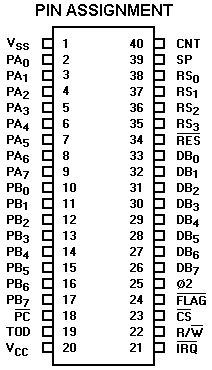8520A COMPLEX INTERFACE ADAPTER


Clock ( ) — The
) — The  clock is a TTL compatible input used for internal device operation and as a timing reference for communicating with the system data bus.
clock is a TTL compatible input used for internal device operation and as a timing reference for communicating with the system data bus.
Chip Select ( ) — The
) — The  input controls the activity of the 8520. A low level on
input controls the activity of the 8520. A low level on  while
while  is high causes the device to respond to signals on the
is high causes the device to respond to signals on the  and address (RS) lines. A high on
and address (RS) lines. A high on  prevents these lines from controlling the 8520. The
prevents these lines from controlling the 8520. The  line is normally activated (low) at
line is normally activated (low) at  by the appropriate address combination.
by the appropriate address combination.
Read/Write ( ) — The
) — The  signal is normally supplied by the microprocessor and controls the direction of data transfers of the 8520. A high on
signal is normally supplied by the microprocessor and controls the direction of data transfers of the 8520. A high on  indicates a read (data transfer out of the 8520), while a low indicates a write (data transfer into the 8520).
indicates a read (data transfer out of the 8520), while a low indicates a write (data transfer into the 8520).
Address Bus (RS3-RS0) — The address inputs select the internal registers as described by the Register Map.
Data Bus (DB7-DB0) — The eight bit data bus transfers information between the 8520 and the system data bus. These pins are high impedance inputs unless  is low and
is low and  and
and  are high, to read the device. During this read, the data bus output buffers are enabled, driving the data from the selected register onto the system data bus.
are high, to read the device. During this read, the data bus output buffers are enabled, driving the data from the selected register onto the system data bus.
Interrupt Request ( ) —
) —  is an open drain output normally connected to the processor interrupt input. An external pullup resistor holds the signal high, allowing multiple
is an open drain output normally connected to the processor interrupt input. An external pullup resistor holds the signal high, allowing multiple  -outputs to be connected together. The
-outputs to be connected together. The  output is normally off (high impedance) and is activated low as indicated in the functional description.
output is normally off (high impedance) and is activated low as indicated in the functional description.
Reset ( ) — A low on the
) — A low on the  pin resets all internal registers. The port pins are set as inputs and port registers to zero (although a read of the ports will return all highs because of passive pullups). The timer control registers are set to zero and the timer latches to all ones. All other registers are reset to zero.
pin resets all internal registers. The port pins are set as inputs and port registers to zero (although a read of the ports will return all highs because of passive pullups). The timer control registers are set to zero and the timer latches to all ones. All other registers are reset to zero.